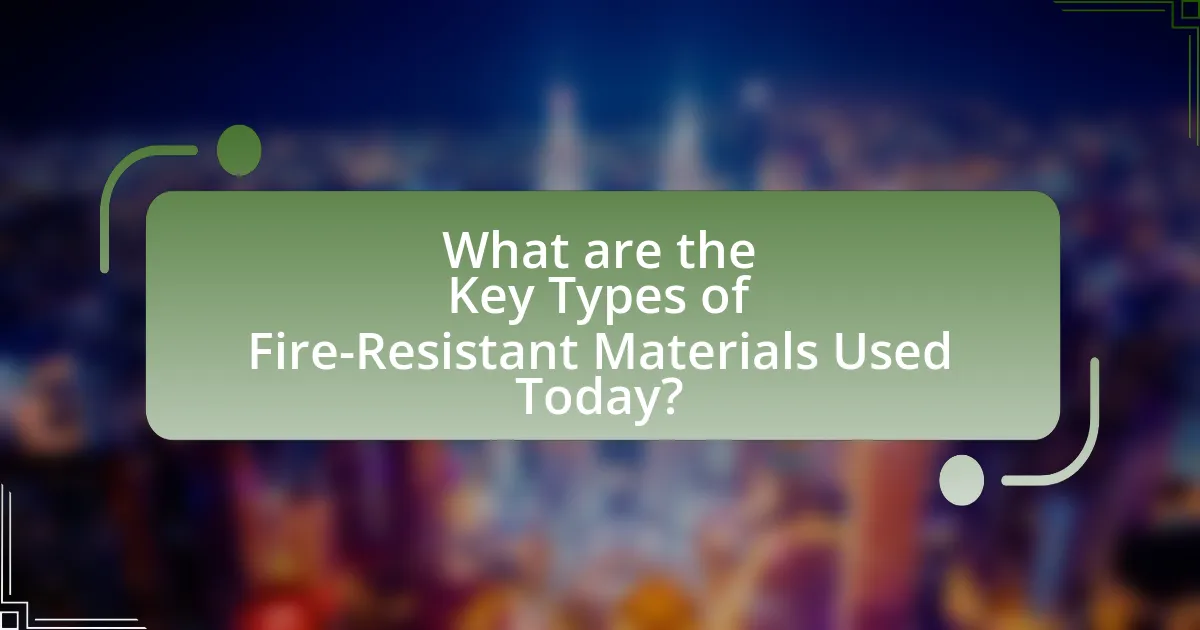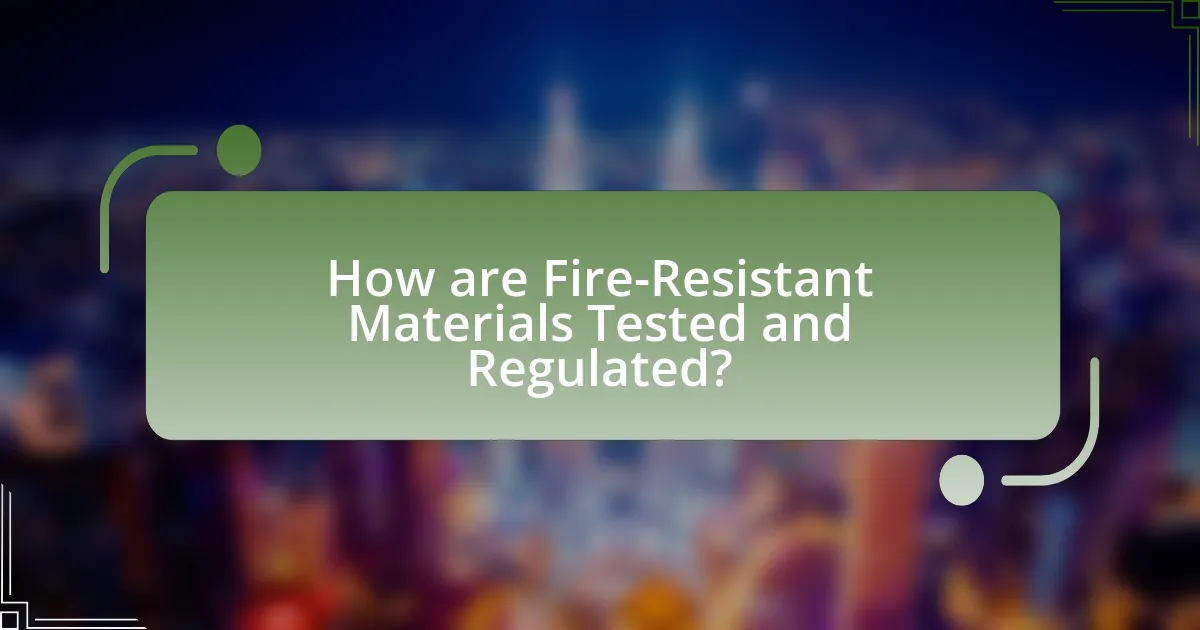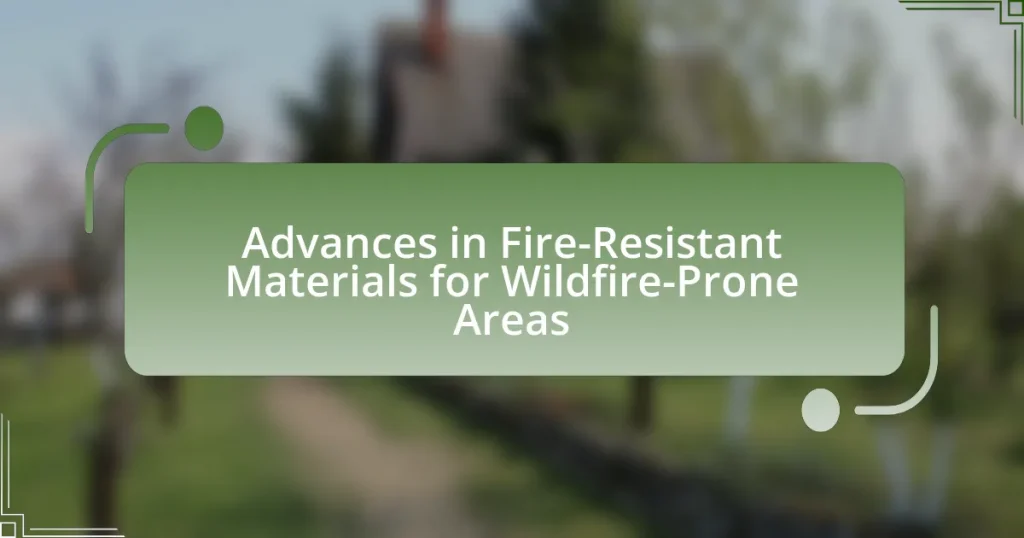Fire-resistant materials are essential for construction and landscaping in wildfire-prone areas, designed to withstand high temperatures and resist ignition. This article explores the various types of fire-resistant materials, such as concrete, steel, and treated wood, and their effectiveness in protecting structures from fire damage. It discusses advancements in fire-resistant technologies, including bio-based retardants and innovative coatings, as well as the importance of testing and regulatory standards. Additionally, the article highlights practical tips for homeowners to enhance fire resistance and the impact of climate change on the development of these materials. Overall, it emphasizes the critical role of fire-resistant materials in improving safety and reducing property damage in areas at risk of wildfires.

What are Fire-Resistant Materials and Why are They Important for Wildfire-Prone Areas?
Fire-resistant materials are substances designed to withstand high temperatures and resist ignition, making them crucial for construction and landscaping in wildfire-prone areas. These materials, such as fiber-cement siding, stucco, and certain treated woods, help to slow the spread of fire and protect structures from direct flame contact. Their importance is underscored by statistics indicating that homes built with fire-resistant materials can significantly reduce the risk of destruction during wildfires, as evidenced by studies showing that fire-resistant building techniques can lower fire damage by up to 80%.
How do fire-resistant materials function in protecting structures?
Fire-resistant materials protect structures by delaying the spread of fire and reducing heat transfer. These materials, such as treated wood, concrete, and specialized coatings, are designed to withstand high temperatures and prevent ignition. For instance, concrete can endure temperatures exceeding 1,000 degrees Celsius without structural failure, while fire-retardant-treated wood can resist flames for extended periods. The effectiveness of these materials is supported by building codes that require their use in wildfire-prone areas, demonstrating their critical role in enhancing safety and minimizing damage during fire events.
What materials are commonly used in fire-resistant construction?
Common materials used in fire-resistant construction include concrete, steel, gypsum board, and fire-retardant-treated wood. Concrete is non-combustible and provides excellent thermal mass, while steel offers high strength and resistance to deformation under heat. Gypsum board contains water in its structure, which helps to slow down heat transfer and prevent flames from spreading. Fire-retardant-treated wood is chemically treated to reduce its flammability, making it safer for use in construction. These materials are widely recognized for their effectiveness in enhancing fire safety in buildings, particularly in wildfire-prone areas.
How do these materials interact with fire and heat?
Fire-resistant materials are designed to withstand high temperatures and resist ignition when exposed to fire. These materials typically incorporate flame-retardant chemicals or are made from inherently non-combustible substances, such as mineral fibers or certain polymers. For instance, materials like fiberglass and certain treated woods can endure significant heat without catching fire, while also limiting the spread of flames. Research indicates that the use of intumescent coatings can enhance the fire resistance of surfaces by expanding when heated, creating a protective barrier. This interaction with fire and heat is critical in wildfire-prone areas, as it helps to protect structures and reduce the risk of fire damage.
What advancements have been made in fire-resistant materials recently?
Recent advancements in fire-resistant materials include the development of bio-based fire retardants and enhanced composite materials that provide superior thermal protection. For instance, researchers have created fire-resistant coatings derived from natural sources, such as plant extracts, which offer an eco-friendly alternative to traditional chemical retardants. Additionally, innovations in fiber-reinforced polymers have led to materials that not only resist ignition but also maintain structural integrity under high temperatures, as demonstrated in studies published in the Journal of Fire Sciences. These advancements are crucial for improving safety in wildfire-prone areas, as they enhance the resilience of buildings and infrastructure against fire hazards.
What innovative technologies are being developed for fire resistance?
Innovative technologies being developed for fire resistance include intumescent coatings, fire-resistant composites, and advanced insulation materials. Intumescent coatings expand when exposed to heat, forming a protective char layer that insulates the underlying material. Fire-resistant composites, such as those incorporating fiberglass or carbon fibers, provide enhanced structural integrity and thermal resistance. Advanced insulation materials, like aerogels and mineral wool, offer superior thermal protection while being lightweight. These technologies are crucial in enhancing safety in wildfire-prone areas, as evidenced by their increasing adoption in construction and material science research.
How do these advancements improve safety and effectiveness?
Advancements in fire-resistant materials enhance safety and effectiveness by significantly reducing the flammability of structures in wildfire-prone areas. These materials, such as intumescent coatings and fire-retardant-treated wood, create barriers that slow down or prevent the spread of fire, thereby protecting lives and property. For instance, studies have shown that buildings constructed with fire-resistant materials can withstand higher temperatures and longer exposure to flames, resulting in a 50% reduction in fire damage compared to traditional materials. This effectiveness is further supported by the National Fire Protection Association, which reports that using fire-resistant materials can decrease the risk of ignition from embers by up to 90%.

What are the Key Types of Fire-Resistant Materials Used Today?
The key types of fire-resistant materials used today include fiberglass, mineral wool, and intumescent coatings. Fiberglass is commonly utilized in insulation and building materials due to its ability to withstand high temperatures without melting. Mineral wool, made from natural or synthetic fibers, offers excellent fire resistance and is often used in wall and ceiling assemblies. Intumescent coatings expand when exposed to heat, forming a protective layer that insulates underlying materials, making them suitable for steel structures. These materials are essential in enhancing fire safety in construction, particularly in wildfire-prone areas, as they help to slow down the spread of flames and protect property.
What are the different categories of fire-resistant materials?
The different categories of fire-resistant materials include passive fire protection materials, active fire protection materials, and fire-retardant treated materials. Passive fire protection materials, such as concrete, gypsum board, and mineral wool, are designed to withstand fire and prevent its spread without any external intervention. Active fire protection materials, like fire extinguishing systems and sprinklers, require activation to function effectively. Fire-retardant treated materials, including wood and textiles that have been chemically treated to resist ignition and slow combustion, are also significant in fire safety. These categories are essential for enhancing safety in wildfire-prone areas, as they help to mitigate the risks associated with fire exposure.
How do passive fire protection materials differ from active systems?
Passive fire protection materials differ from active systems in that they are designed to contain or slow the spread of fire without requiring any action or activation, while active systems rely on mechanical or electronic components to detect and extinguish fires. Passive systems include fire-resistant walls, floors, and doors that provide structural integrity during a fire, whereas active systems, such as sprinklers and fire alarms, require power and maintenance to function effectively. The effectiveness of passive fire protection is evidenced by building codes that mandate fire-resistive construction materials in high-risk areas, demonstrating their critical role in fire safety.
What role do coatings and treatments play in enhancing fire resistance?
Coatings and treatments significantly enhance fire resistance by forming protective barriers that slow down heat transfer and combustion. These materials, such as intumescent coatings, expand when exposed to high temperatures, creating an insulating layer that protects the underlying substrate from flames. For instance, studies have shown that intumescent coatings can reduce the temperature of structural elements by up to 300 degrees Fahrenheit during a fire, thereby prolonging their integrity and stability. Additionally, fire-retardant treatments applied to wood and textiles can reduce flammability and slow ignition, contributing to overall fire safety in wildfire-prone areas.
What are the benefits of using advanced fire-resistant materials?
Advanced fire-resistant materials significantly enhance safety and property protection in wildfire-prone areas. These materials are designed to withstand high temperatures and prevent the spread of flames, thereby reducing the risk of fire damage to structures. For instance, studies have shown that buildings constructed with fire-resistant materials can experience up to 75% less damage during wildfires compared to those made with traditional materials. Additionally, the use of these materials can lead to lower insurance premiums and increased property values, as they are viewed as safer investments.
How do these materials contribute to building longevity?
Fire-resistant materials enhance building longevity by significantly reducing the risk of fire damage, thereby prolonging the structural integrity and lifespan of buildings in wildfire-prone areas. These materials, such as non-combustible cladding, fire-retardant-treated wood, and specialized insulation, are designed to withstand high temperatures and prevent the spread of flames. For instance, studies have shown that structures utilizing fire-resistant materials can survive extreme wildfire conditions, as evidenced by the 2018 Camp Fire in California, where homes built with such materials experienced less damage compared to those constructed with traditional materials. This effectiveness in fire resistance not only protects the physical structure but also minimizes repair costs and enhances safety for occupants, ultimately contributing to the overall longevity of buildings in vulnerable regions.
What cost savings can be realized through the use of fire-resistant materials?
The use of fire-resistant materials can lead to significant cost savings by reducing property damage and insurance premiums. Specifically, structures built with these materials are less likely to be destroyed in wildfires, which can save homeowners and businesses from the high costs associated with rebuilding and repairs. According to a study by the National Institute of Standards and Technology, homes constructed with fire-resistant materials can experience up to a 50% reduction in fire-related losses compared to those built with traditional materials. Additionally, insurance companies often offer lower premiums for properties that utilize fire-resistant construction, further enhancing overall savings.

How are Fire-Resistant Materials Tested and Regulated?
Fire-resistant materials are tested and regulated through standardized methods established by organizations such as ASTM International and the National Fire Protection Association (NFPA). These organizations define specific testing protocols, such as ASTM E84 for surface burning characteristics and NFPA 701 for flame propagation, to evaluate the performance of materials under fire conditions. Compliance with these standards ensures that materials meet safety requirements and can effectively resist ignition and slow the spread of fire, thereby protecting structures in wildfire-prone areas.
What standards exist for testing fire-resistant materials?
Standards for testing fire-resistant materials include ASTM E119, which evaluates the fire-resistance of building elements, and NFPA 701, which tests the flammability of textiles and films. ASTM E119 specifies the duration a material can withstand fire exposure, while NFPA 701 assesses the ignition resistance of materials used in interior applications. These standards are critical for ensuring that materials meet safety requirements in wildfire-prone areas, as they provide a framework for evaluating performance under fire conditions.
How do testing methods ensure reliability and safety?
Testing methods ensure reliability and safety by systematically evaluating materials under controlled conditions to assess their performance against specific standards. These methods include fire resistance tests, which measure how well materials withstand high temperatures and flames, and durability assessments, which evaluate long-term performance in various environmental conditions. For instance, the ASTM E119 standard outlines fire tests for building materials, providing a benchmark for safety and reliability. By adhering to such established protocols, manufacturers can ensure that their fire-resistant materials meet regulatory requirements and perform effectively in real-world wildfire scenarios.
What regulatory bodies oversee fire-resistant material standards?
The regulatory bodies that oversee fire-resistant material standards include the National Fire Protection Association (NFPA), Underwriters Laboratories (UL), and the International Code Council (ICC). The NFPA develops codes and standards to minimize fire risks, while UL conducts safety testing and certification for various materials. The ICC establishes building codes that incorporate fire safety measures, ensuring compliance with fire-resistant standards. These organizations collectively contribute to the establishment and enforcement of regulations that govern fire-resistant materials, thereby enhancing safety in wildfire-prone areas.
What challenges are faced in the development of fire-resistant materials?
The development of fire-resistant materials faces several challenges, including the need for effective performance under extreme heat, cost-effectiveness, and environmental sustainability. Effective performance is critical, as materials must withstand high temperatures and prevent ignition; for instance, materials must maintain structural integrity at temperatures exceeding 1,000 degrees Fahrenheit. Cost-effectiveness is another challenge, as advanced fire-resistant materials often require expensive raw materials or complex manufacturing processes, which can limit their adoption in construction. Additionally, environmental sustainability poses a challenge, as some fire-resistant treatments may involve toxic chemicals that can harm ecosystems, necessitating the development of safer alternatives. These challenges highlight the complexity of creating materials that are not only effective but also economically viable and environmentally friendly.
How do environmental concerns impact material selection?
Environmental concerns significantly influence material selection by prioritizing sustainability and reducing ecological impact. For instance, materials that are renewable, recyclable, or have lower carbon footprints are increasingly favored in construction and manufacturing processes. Research indicates that using fire-resistant materials derived from sustainable sources, such as bamboo or recycled metals, can mitigate environmental degradation while enhancing safety in wildfire-prone areas. Additionally, regulations and certifications, such as LEED (Leadership in Energy and Environmental Design), encourage the adoption of environmentally friendly materials, further shaping choices in material selection.
What are the limitations of current fire-resistant technologies?
Current fire-resistant technologies face several limitations, including reduced effectiveness over time, high costs, and limited application versatility. For instance, many fire-resistant materials degrade when exposed to extreme heat or environmental conditions, diminishing their protective capabilities. Additionally, advanced fire-resistant materials can be prohibitively expensive, making widespread adoption challenging, particularly for low-budget projects. Furthermore, some technologies are not suitable for all building types or materials, restricting their use in diverse construction scenarios. These limitations highlight the need for ongoing research and development to enhance the performance and accessibility of fire-resistant solutions.

What Future Trends Can We Expect in Fire-Resistant Materials?
Future trends in fire-resistant materials include the development of bio-based and nanotechnology-enhanced materials that offer improved thermal resistance and environmental sustainability. Research indicates that materials incorporating nanomaterials, such as graphene and silica aerogels, can significantly enhance fire resistance while reducing weight and improving insulation properties. Additionally, advancements in smart materials that can respond to heat and flames are emerging, allowing for dynamic protection in wildfire-prone areas. These trends are supported by ongoing studies in material science, which highlight the effectiveness of innovative compounds in enhancing fire resistance and reducing the ecological impact of traditional materials.
How is research shaping the future of fire-resistant materials?
Research is significantly shaping the future of fire-resistant materials by developing innovative compounds and technologies that enhance their effectiveness. Recent studies, such as those published in the Journal of Fire Sciences, demonstrate that incorporating nanomaterials, like graphene and silica aerogels, can improve thermal stability and reduce flammability in various substrates. Additionally, advancements in bio-based fire retardants, derived from natural sources, are being explored for their environmental benefits and effectiveness, as highlighted in research from the University of California. These developments not only aim to meet stricter safety regulations but also address the increasing frequency of wildfires, making fire-resistant materials more crucial in construction and landscaping in wildfire-prone areas.
What emerging materials show promise for enhanced fire resistance?
Emerging materials that show promise for enhanced fire resistance include intumescent coatings, aerogels, and fire-retardant polymers. Intumescent coatings expand when exposed to heat, forming a protective char layer that insulates the underlying material. Aerogels, known for their low density and high thermal resistance, can withstand extreme temperatures while providing insulation. Fire-retardant polymers are engineered to resist ignition and slow down flame spread, making them suitable for various applications in wildfire-prone areas. These materials are being researched and developed to improve safety and resilience against wildfires, as evidenced by studies highlighting their effectiveness in reducing fire spread and enhancing structural integrity.
How might climate change influence the development of these materials?
Climate change may accelerate the development of fire-resistant materials due to increased frequency and intensity of wildfires. As global temperatures rise and weather patterns shift, regions previously considered safe from wildfires are experiencing more extreme fire conditions. This necessitates the innovation and enhancement of materials that can withstand higher temperatures and resist ignition. For instance, research indicates that the U.S. Forest Service has reported a 40% increase in the area burned by wildfires over the past three decades, highlighting the urgent need for improved fire-resistant materials in construction and landscaping. Consequently, manufacturers and researchers are focusing on developing advanced composites and coatings that can better protect structures in wildfire-prone areas.
What practical tips can homeowners use to enhance fire resistance?
Homeowners can enhance fire resistance by using non-combustible materials for roofing and siding, such as metal or stucco, which significantly reduce the risk of ignition from embers. Additionally, maintaining a defensible space around the home by clearing flammable vegetation and debris within a 30-foot radius can prevent fire spread. Installing tempered glass windows and using fire-resistant doors further protects the home from heat and flames. According to the National Fire Protection Association, homes with these features are less likely to be damaged during wildfires, demonstrating the effectiveness of these strategies in fire-prone areas.
How can property owners select the best fire-resistant materials for their needs?
Property owners can select the best fire-resistant materials by evaluating their specific needs, understanding material ratings, and considering local building codes. First, they should assess the fire risk in their area, which can guide the choice of materials that offer the highest resistance to flames and heat. Next, property owners should look for materials that have been tested and rated by organizations such as Underwriters Laboratories (UL) or the American Society for Testing and Materials (ASTM), which provide reliable data on fire performance. Additionally, consulting local building codes ensures compliance with regulations that may dictate the use of certain fire-resistant materials, such as non-combustible siding or roofing materials. By combining these strategies, property owners can make informed decisions that enhance the fire safety of their properties.
What maintenance practices can prolong the effectiveness of fire-resistant materials?
Regular inspections and cleaning of fire-resistant materials can significantly prolong their effectiveness. Maintaining these materials involves checking for damage, ensuring proper installation, and removing debris that could compromise their fire resistance. For instance, studies indicate that fire-resistant coatings can lose effectiveness if not maintained, as environmental factors like moisture and UV exposure can degrade their properties over time. Additionally, applying protective sealants can enhance durability and resistance to wear, further extending the lifespan of fire-resistant materials.




